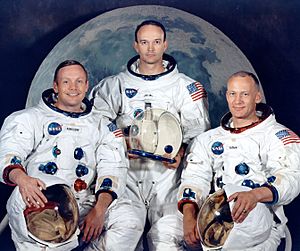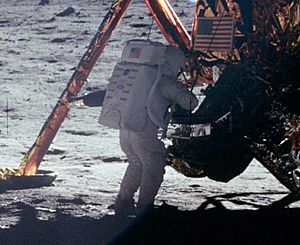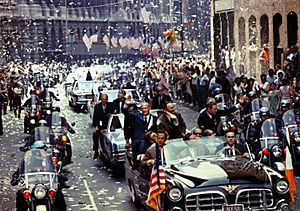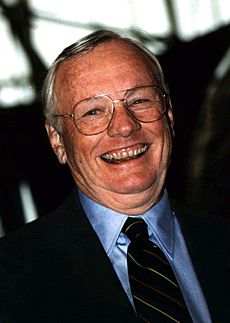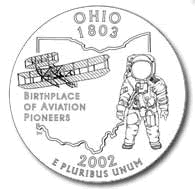Neil Armstrong facts for kids
Quick facts for kids
Neil Armstrong
|
|
|---|---|
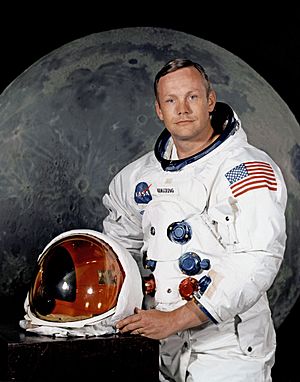
Armstrong in 1969
|
|
| Born |
Neil Alden Armstrong
August 5, 1930 Wapakoneta, Ohio, U.S.
|
| Died | August 25, 2012 (aged 82) Cincinnati, Ohio, U.S.
|
| Alma mater | |
| Awards |
|
| Space career | |
| USAF / NASA astronaut | |
|
Previous occupation
|
|
| Rank | Lieutenant (junior grade), USN |
|
Time in space
|
8 days 14 hours 12 minutes and 30 seconds |
| Selection |
|
|
Total EVAs
|
1 |
|
Total EVA time
|
2 hours 31 minutes |
| Missions |
|
|
Mission insignia
|
  |
| Spouse(s) |
Janet Shearon
(m. 1956; div. 1994)Carol Knight
(m. 1994) |
| Children | 3 |
| Signature | |
 |
|
Neil Alden Armstrong (born August 5, 1930 – died August 25, 2012) was an American astronaut and engineer. He became the first person to walk on the Moon in 1969. He was also a naval aviator, test pilot, and university professor.
Contents
Neil Armstrong's Early Life
Neil Armstrong was born in Wapakoneta, Ohio, on August 5, 1930. His parents were Viola Louise and Stephen Koenig Armstrong. His family moved often because his father worked for the Ohio state government. They lived in 16 different towns over 14 years.
In 1944, his family moved back to Wapakoneta. Neil went to Blume High School there. He started taking flying lessons at the local airfield. On his 16th birthday, he earned a student flight certificate. He flew a plane alone in August, even before he had a driver's license!
Boy Scout Adventures
Neil was a very active Boy Scout. He earned the highest rank, Eagle Scout. As an adult, the Scouts honored him with special awards. While flying to the Moon in 1969, he sent greetings to a large Boy Scout meeting in Idaho. He even carried a World Scout Badge with him to the Moon and back.
At age 17, in 1947, Neil began studying aeronautical engineering at Purdue University in Indiana. He chose Purdue after seeing their football team win a big game. His uncle also told him he could get a great education there.
His college studies were paid for by the Holloway Plan. This plan meant students would study for two years, then train as pilots for two years. After that, they would serve one year in the U.S. Navy. Finally, they would finish their last two years of college.
Career as a Pilot and Engineer
Neil became a midshipman in the Navy in 1949. He became a naval aviator (pilot) the next year. He flew planes during the Korean War from the aircraft carrier USS Essex.
After the war, he finished his bachelor's degree at Purdue in 1955. Later, in 1970, he earned his Master of Science degree in Aerospace Engineering from the University of Southern California. Many universities also gave him honorary doctorates.
Becoming a Test Pilot
After college, Neil became a test pilot at the National Advisory Committee for Aeronautics (NACA). This was at Edwards Air Force Base in California.
He worked on many important aircraft projects. He flew the North American X-15 seven times. This was a rocket-powered aircraft that flew at very high speeds and altitudes. He was also part of early human spaceflight programs for the U.S. Air Force.
Neil Armstrong's Astronaut Career
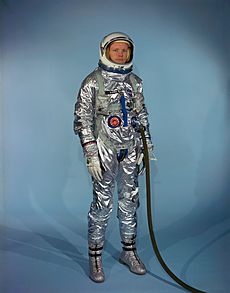
Neil Armstrong joined the NASA Astronaut Corps in 1962. He was part of the second group of astronauts chosen by NASA.
His first trip to space was as the commander of Gemini 8 in March 1966. He was the first civilian astronaut from NASA to fly in space. During this mission, he and pilot David Scott performed the first ever docking of two spacecraft in orbit. This was a very important step for future space missions.
Before his second spaceflight, Apollo 11, Neil had a close call. He had to eject from a training vehicle called the Lunar Landing Research Vehicle just moments before it crashed.
Landing on the Moon
Journey to the Moon
The Apollo 11 mission launched from the Kennedy Space Center on July 16, 1969. A powerful Saturn V rocket carried the crew into space. Neil's wife and two sons watched the launch from a yacht. During the launch, Neil's heart beat very fast!
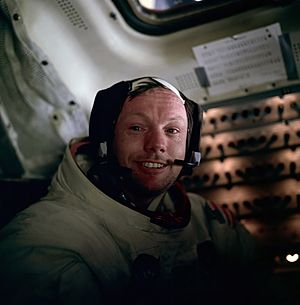
The spacecraft landed on the Moon on July 20, 1969. Neil announced the landing to Mission Control and the world. He said, "Houston, Tranquility Base here. The Eagle has landed." Neil and Buzz Aldrin shook hands and patted each other on the back to celebrate.
First Steps on the Moon
When Neil Armstrong first stepped onto the Moon's surface, he said his famous words: "That's one small step for [a] man, one giant leap for mankind." About 530 million people around the world watched this live on TV.
Neil thought about these words before leaving the lunar module. He knew there was a good chance of returning to Earth. But he felt the chances of landing successfully on the Moon were about 50/50. He didn't want to plan what to say if they had to stop the landing.
About 19 minutes after Neil, Buzz Aldrin joined him on the Moon. They started exploring to see how easy it was for a person to move around. Neil put up a plaque to remember the flight. Then, he and Buzz planted the flag of the United States. The flag looked wavy because a metal rod used to hold it out didn't fully extend.
Soon after, President Richard Nixon spoke to them by phone from Earth. Neil and Buzz spent about two and a half hours exploring the Moon. Later missions spent much longer exploring. Neil explained that NASA limited their Moon walk because they weren't sure how the space suits would handle the Moon's extreme temperatures.
Returning Home

As they prepared to leave the Moon, Neil and Buzz accidentally broke a switch needed to start the engine. They used part of a pen to push the circuit breaker and start the launch!
After reaching lunar orbit, their lunar module, Eagle, connected with the command module, Columbia. The three astronauts then returned to Earth. They splashed down in the Pacific Ocean and were picked up by the USS Hornet.
They had to stay in quarantine for 18 days. This was to make sure they didn't bring back any unknown germs from the Moon. After that, they were celebrated all over the United States and the world. President Nixon gave each astronaut the Presidential Medal of Freedom.
In May 1970, Neil traveled to the Soviet Union. He was the first person from the West to see their supersonic plane, the Tupolev Tu-144. He also toured the Yuri Gagarin Cosmonaut Training Center.
Life After Space Missions

Neil Armstrong left NASA in 1971. He then taught in the Aerospace Engineering Department at the University of Cincinnati until 1980. He also helped investigate accidents like the Space Shuttle Challenger disaster.
After retiring from NASA, Neil became a spokesperson for several American companies. He also served on the board of directors for various businesses.
Neil Armstrong's Family Life
Neil met Janet Elizabeth Shearon at a college party. They married on January 28, 1956. They had three children: Eric, Karen, and Mark. Sadly, their daughter Karen passed away at age two from a brain tumor.
Neil and Janet divorced in 1994 after 38 years of marriage. He later met Carol Held Knight at a golf tournament. They married in Ohio on June 12, 1994. They lived in Indian Hill, Ohio.
Famous Words and Quotes
Neil Armstrong's most famous quote is: "That's one small step for (a) man, one giant leap for mankind."
He said these words when he first stepped on the Moon. He meant to say "for a man," but the "a" was not heard. Neil believed he had said it. When written, he preferred the "a" to be included in parentheses.
Other Inspiring Quotes
- "Research is creating new knowledge."
- "Mystery creates wonder and wonder is the basis of man's desire to understand."
- "I believe every human has a finite number of heartbeats. I don't intend to waste any of mine."
Neil Armstrong's Passing
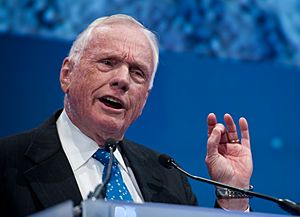
Neil Armstrong had heart surgery in August 2012. He was recovering well, but then developed complications. He passed away on August 25, 2012, at the age of 82.
A tribute was held for him in Washington D.C. on September 13. His ashes were scattered in the Atlantic Ocean on September 14. Flags across the United States were flown at half-staff on the day of his funeral.
Interesting Facts About Neil Armstrong

- Neil's love for flying began when he was just two years old. His father took him to the Cleveland Air Races.
- When he was five or six, he took his first airplane ride in a Ford Trimotor.
- In the late 1950s, he identified as a deist when applying to lead a Boy Scout troop.
- He was the second person in his family to attend college.
- In college, he wrote and helped direct two musicals.
- He played the baritone horn in the Purdue All-American Marching Band.
- In 1972, Neil visited Langholm, Scotland, the traditional home of Clan Armstrong. He was made the first "freeman" of the town and happily called it his home.
- In 1985, he traveled to the North Pole with an expedition. He wanted to see it from the ground, as he had only seen it from the Moon.
- From 1991 to 1993, he hosted First Flights with Neil Armstrong, a TV series about aviation history.
- In 2010, he voiced a character in an animated educational sci-fi film called Quantum Quest: A Cassini Space Odyssey.
- Neil was very careful about how his name and famous quote were used. He sued Hallmark Cards in 1994 for using his name and quote on a Christmas ornament without his permission.
- He used to sign autographs for everything except "first day covers" (stamps on their first day of issue). Around 1993, he stopped signing autographs because many fake signatures were being sold online.
- The lunar crater Armstrong, near the Apollo 11 landing site, is named after him. So is the asteroid 6469 Armstrong.
- Many schools, streets, and buildings around the world are named after Neil Armstrong or the Apollo missions.
- The Armstrong Air and Space Museum in his hometown of Wapakoneta, Ohio, is named after him.
- The mineral armstrongite is named after him, and the mineral armalcolite is partly named after him.
- His official biography, First Man: The Life of Neil A. Armstrong, was published in 2005. A movie based on the book was released in 2018.
- In a 2010 survey, Neil Armstrong was ranked the number-one most popular space hero.
Awards and Honors
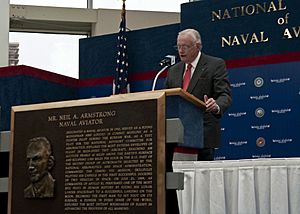
The Apollo 11 mission was a huge win for the US in the Space Race.
Neil Armstrong received many awards and honors. These include:
- The Presidential Medal of Freedom from President Nixon.
- The Congressional Space Medal of Honor from President Jimmy Carter.
- A Congressional Gold Medal in 2011.
- The NASA Distinguished Service Medal.
He was also elected as a member of the National Academy of Engineering in 1978. This was for his important work in aerospace engineering and space exploration.
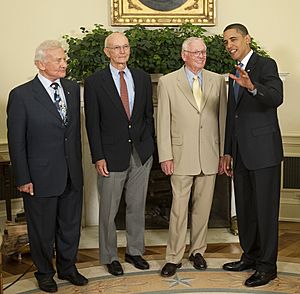
In 1999, Neil and his Apollo 11 crewmates received the Langley Gold Medal. In 2006, he received NASA's Ambassador of Exploration Award. He was also inducted into several Halls of Fame, including the National Aviation Hall of Fame and the United States Astronaut Hall of Fame.
Purdue University named its new engineering building the Neil Armstrong Hall of Engineering in 2004. The NASA Dryden Flight Research Center was renamed the NASA Neil A. Armstrong Flight Research Center in 2014. In 2012, the U.S. Navy named a research vessel RV Neil Armstrong after him.
The planetarium at Altoona Area High School in Pennsylvania is named after Neil Armstrong. A campsite at Yawgoog Scout Reservation in Rhode Island is also named in his honor, recognizing his Scouting background.
In 2018, Neil's sons sold some of his personal items. These included his Boy Scout cap, flags, and medals from his space missions. Pieces of wood and fabric from the 1903 Wright Flyer that Neil took to the Moon sold for a lot of money.
Neil Armstrong donated his papers to Purdue University. His widow, Carol, also donated more materials after his death. This collection has over 450 boxes of important items.
See also
 In Spanish: Neil Armstrong para niños
In Spanish: Neil Armstrong para niños




